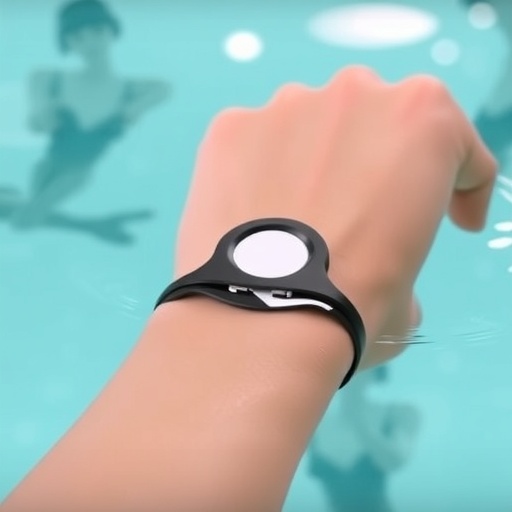In the ever-evolving world of sports technology, a significant leap has been made in the realm of aquatic sports with the introduction of a cutting-edge wireless pressure sensor aimed at transforming swimming performance analysis. This innovative device promises to provide swimmers and coaches with unprecedented insights into performance metrics, ultimately allowing for tailored training regimens that align with individual athlete needs and capabilities. The technical specifications of this wireless pressure sensor are designed to enhance the accuracy and reliability of data collection in real-time, offering detailed assessments that were previously unattainable with traditional methods.
The wireless pressure sensor operates using a sophisticated combination of pressure transducers and advanced wireless communication protocols. This allows for the collection of pressure data specifically related to the force exerted by swimmers during different phases of their strokes. By capturing minute changes in pressure as swimmers navigate through water, coaches can now analyze propulsion forces with remarkable precision. The implications of this technology extend beyond mere performance metrics; they promote a deeper understanding of swimming technique, which is critical for improving efficiency in the water.
Reliability is a cornerstone of this wireless pressure sensor’s design, ensuring that the data it collects is consistent and trustworthy. Engineers have developed rigorous testing protocols to validate the sensor’s performance under various environmental conditions, simulating the typical scenarios swimmers encounter. This includes testing the sensor under different water temperatures, currents, and swimmer movements, thus ensuring that the technology can withstand the demands of real-world athletic scenarios.
In conjunction with its reliability, accuracy is another key feature of this innovation. The wireless pressure sensor has been calibrated to provide high-resolution readings that reflect the actual forces applied by swimmers. This level of detail allows for a comprehensive analysis of each swimmer’s performance, enabling coaches to pinpoint specific areas where improvements can be made. Accuracy in data collection is particularly vital when analyzing the strokes of elite athletes, where even the slightest variations can lead to significant changes in outcome.
Moreover, the ecological validity of the wireless pressure sensor cannot be overlooked. Unlike some previous technologies, this device has been designed to accommodate the natural conditions experienced by swimmers in competitive settings. By integrating seamlessly into the existing gear used by athletes, such as swim caps or suits, the sensor allows for unobtrusive monitoring without compromising performance or comfort. This aspect significantly enhances the practicality and acceptance of the technology within professional swimming circles.
One of the most impressive aspects of the wireless pressure sensor is its ability to integrate with existing software platforms used for performance analysis. Coaches and athletes can easily visualize data through intuitive applications that display insights derived from the sensor readings. This integration not only streamlines the data analysis process but also enhances the collaborative efforts between swimmers and their coaching teams. With access to real-time data, athletes can make immediate adjustments to their techniques, leading to faster improvements and optimized training sessions.
The performance feedback provided by the wireless pressure sensor can also aid in injury prevention, a crucial aspect of any athlete’s career. By identifying inefficient stroke mechanics or undue strain on specific muscle groups, coaches can implement corrective measures before injuries occur. This proactive approach not only protects the physical wellbeing of athletes but also extends their careers, allowing them to compete at high levels for longer periods.
In terms of its potential applications, this wireless pressure sensor is not solely limited to elite competitive swimmers. It also holds promise for recreational swimmers and those undergoing rehabilitation. The ability to monitor swimming techniques for individuals at various skill levels enables a more personalized training experience, fostering a greater understanding of the sport among amateurs. Such inclusivity in the development of sports technology is crucial for promoting swimming as a lifelong activity.
Furthermore, the broader implications of this technology extend beyond swimming. Concepts and methodologies derived from the development and implementation of the wireless pressure sensor can be applied to other water sports, potentially revolutionizing the way performance is measured across disciplines. This cross-disciplinary applicability opens up new avenues for research and innovation that may significantly alter the landscape of aquatic sports technologies in the coming years.
As the initial studies and validations of the device have begun, significant interest has been generated from various sectors within the sports community. Swimming coaches worldwide have expressed eagerness to integrate this technology into their training programs, anticipating the positive impact on their athletes’ performances. Competitive swimming teams that adopt this technology early might gain a significant edge over their opponents, particularly as the sports community begins to embrace data-driven training methods.
In conclusion, the wireless pressure sensor represents a noteworthy advancement in sports technology with the potential to redefine swimming performance analysis. Its reliability, accuracy, and ecological validity make it an indispensable tool for coaches and athletes seeking to gain a competitive advantage. As this technology continues to evolve and integrate into the training regimens of swimmers, the future of aquatic sports looks promising, with data-driven methodologies paving the way for enhanced athletic performance.
As we look ahead, the partnership between technology and sports will only deepen, providing athletes with tools that not only measure performance but also enhance their overall experience in the water. The wireless pressure sensor is a prime example of how innovation can lead to substantial changes in training practices, making swimming not only a sport but also an avenue for continuous improvement and understanding.
Subject of Research: Wireless pressure sensor for swimming performance analysis.
Article Title: Reliability, accuracy and ecological validity of a wireless pressure sensor for swimming performance analysis.
Article References:
Coloretti, V., Russo, G., Bartolomei, S. et al. Reliability, accuracy and ecological validity of a wireless pressure sensor for swimming performance analysis. Sports Eng 28, 32 (2025). https://doi.org/10.1007/s12283-025-00512-9
Image Credits: AI Generated
DOI:
Keywords: Swimming technology, performance analysis, wireless sensor, aquatic sports, data technology, training improvement.




